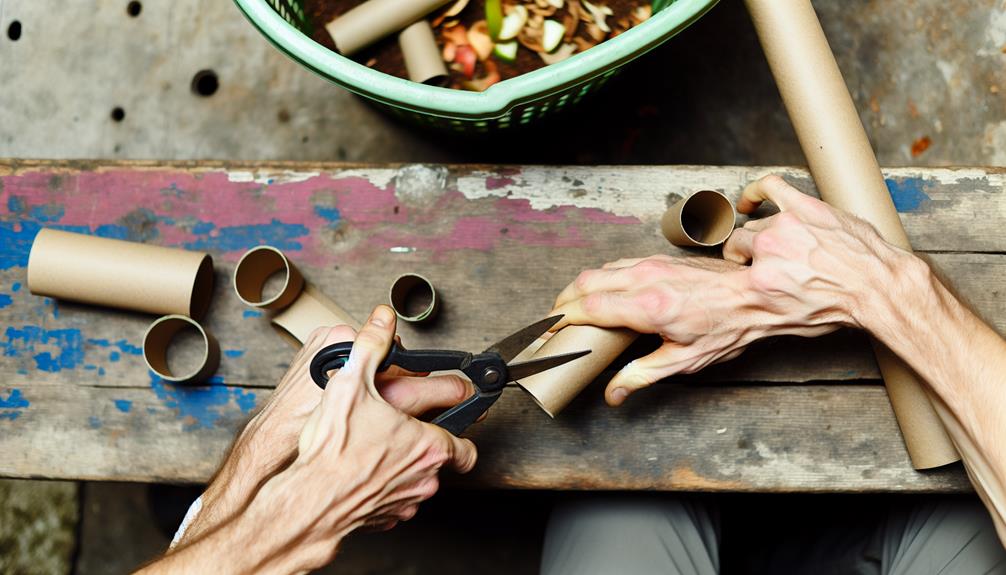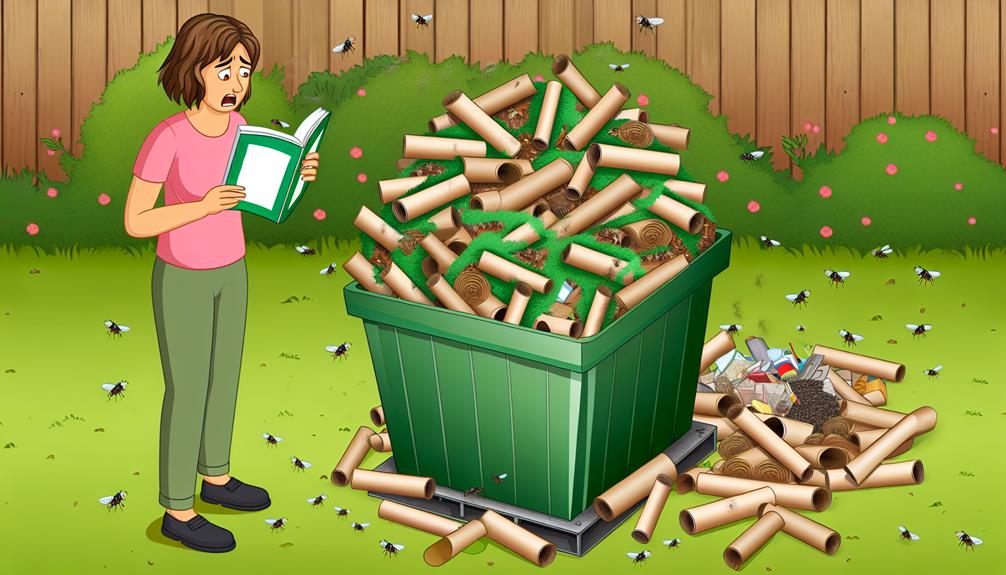

Absolutely, you can compost cardboard tubes! They’re an excellent source of essential carbon-rich brown matter, vital for a balanced compost. Start with toilet paper or paper towel rolls, remove any tape or stickers, and break them into smaller pieces for faster decomposition.
Soaking them in water with a little liquid detergent helps too! Combining these tubes with green nitrogen-rich materials speeds up the breakdown process, keeping your compost pile odor-free and nutrient-dense. Besides reducing landfill waste, composting promotes sustainable gardening practices and supports the environment. Ready to boost your composting game even more? There’s plenty more to uncover!
Composting cardboard tubes offers several environmental and gardening benefits. By adding cardboard tubes to your compost, you’re reducing waste that would otherwise end up in landfills, promoting environmental sustainability.
The shredded cardboard provides essential carbon-rich material, which speeds up decomposition and balances the nitrogen in your compost pile. This helps create rich, fertile compost that can greatly improve soil health.
Not only do the cardboard tubes break down quickly, but they also help aerate the compost, improving airflow and preventing it from becoming too compact. This enhanced aeration guarantees an efficient composting process.
Ultimately, using cardboard tubes in your compost enriches your garden soil, resulting in healthier plants and a more vibrant garden community.
Also Read: Can You Compost Apple?
When considering types of cardboard tubes for composting, you’ll find that both toilet paper rolls and paper towel rolls are excellent options. These cardboard tubes are high-carbon materials, which are essential for a balanced compost pile.
Made from biodegradable cardboard, they break down relatively quickly and contribute greatly to creating rich compost. Including these tubes in your composting efforts not only reduces waste sent to landfills but also fosters a more sustainable environment.
To prepare cardboard tubes for composting, start by removing any non-compostable elements like tape or stickers. This guarantees the cardboard decomposes efficiently.

Next, break the tubes into smaller pieces to speed up the process. For an extra boost, soak the pieces in water with liquid detergent to soften them.
Follow these steps to integrate the cardboard into your compost:
Also Read: Can You Compost Alfalfa Sprouts?
Balancing green and brown matter in your compost is essential for creating rich, healthy soil, and cardboard tubes are perfect brown matter due to their high carbon content.
By mixing cardboard tubes with nitrogen-rich green matter like vegetable scraps, you achieve the ideal compost mix that speeds up decomposition and prevents unpleasant odors.
Shredding or cutting the tubes into smaller pieces can further enhance this process, ensuring your compost pile stays balanced and breaks down efficiently.
Carbon content in cardboard tubes is essential for balancing the nitrogen-rich green materials in your compost pile. When you’re composting, these tubes help offset the nitrogen from food scraps and grass clippings, leading to a healthier compost.
By adding shredded cardboard tubes, you promote quicker decomposition and create an ideal environment for beneficial microbes. This sustainable practice not only reduces landfill waste but also enriches your compost mix.
To make the most of cardboard tubes in composting, remember to:
Utilizing cardboard tubes transforms waste into a valuable resource for your garden!
Incorporating both green and brown matter, such as food scraps and shredded cardboard tubes, is essential to achieving an ideal compost mix. Composting cardboard provides vital carbon-rich materials, which balance the nitrogen in food scraps.
When you shred cardboard tubes before adding them to your compost, you speed up the decomposition process, creating a thriving environment for beneficial microbes. This balance of brown and green matter guarantees that your compost pile breaks down efficiently, producing nutrient-rich soil for your garden.
Before composting cardboard tubes, make sure they’re free from tape, stickers, and any plastic caps. These contaminants can hinder the decomposition process and harm your compost pile.
To guarantee your cardboard tubes are contaminant-free, follow these steps:
To speed up the decomposition of cardboard tubes, start by shredding them into smaller pieces to increase their surface area.
Keep the compost moist, but not soggy, to maintain ideal moisture levels.
Balance the carbon-nitrogen ratio by adding nitrogen-rich materials like grass clippings or coffee grounds along with your shredded cardboard tubes.
Shredding cardboard tubes into smaller pieces greatly accelerates their decomposition in a compost pile. When you break them down, you create more surface area, allowing microbes to work faster.
Adding shredded cardboard tubes to your compost pile can transform your waste into nutrient-rich compost in just a few weeks to months.
Here’s why it works:
Maintaining proper moisture levels in your compost pile is essential for speeding up the decomposition of cardboard tubes. By keeping your compost pile adequately moist, you create an environment where beneficial microorganisms can thrive and break down the cardboard efficiently.
If the pile gets too dry, decomposition slows, but if it’s too wet, it can become soggy and smelly. Aim for a consistency similar to a damp sponge. Regularly check and adjust the moisture by adding water if it’s dry or incorporating dry materials if it’s too wet.
This balance guarantees your cardboard tubes transform quickly into nutrient-rich compost, fostering a sense of community as you contribute to a sustainable, eco-friendly practice.
Maintaining the carbon-nitrogen ratio is essential for speeding up the decomposition of cardboard tubes in your compost pile. Cardboard tubes are rich in carbon, which balances out nitrogen-rich materials like grass clippings or kitchen scraps. This balance creates an ideal environment for beneficial microorganisms to thrive, accelerating the breakdown process.
To make the most of your compost pile, follow these tips:
Also Read: Can You Compost Alcohol?
When composting cardboard tubes, one common mistake to avoid is including those with shiny or coated surfaces that contain non-compostable materials. These coatings can hinder the decomposition process and introduce harmful chemicals into your compost.

Be sure to avoid shiny or coated cardboard, and always check for heavy dyes or inks. Before you compost cardboard tubes, remove any tape, labels, or non-biodegradable elements to keep your compost clean.
Shredding cardboard tubes into smaller pieces can speed up their breakdown, making your composting efforts more effective. By following these steps, you’ll help reduce waste in landfills and contribute to sustainable gardening practices, fostering a sense of community and environmental stewardship.
Discovering creative ways to reuse cardboard tubes can extend their life and add practicality to your everyday routines. Not only can you reduce waste, but you can also create functional items that enhance your home and garden.
Instead of tossing them into your compost pile right away, try these creative reuse ideas:
These simple yet effective tricks help you feel resourceful and environmentally conscious. Embrace these ideas to foster a sense of belonging within a community that values sustainability and creativity.
Yes, it’s safe to compost cardboard. Make sure it’s free of non-compostable materials like tape or labels. By composting cardboard, you’re reducing landfill waste and adding valuable carbon-rich material to your compost.
You shouldn’t compost cardboard with glossy coatings, heavy dyes, plastic, or wax. Remove any tape or labels first. Stick to plain, untreated cardboard to keep your compost healthy and free from harmful chemicals.
You can compost cardboard food containers, but make sure they’re free of plastic coatings, wax, or grease. Shredding them will help them break down faster. Composting these containers helps our community reduce waste and be more sustainable.
Yes, you should soak cardboard before composting. It breaks down faster, balances moisture, and attracts beneficial decomposers like worms. You’ll enhance the composting process and feel more connected to your eco-friendly community.
Composting cardboard tubes is a fantastic way to enrich your soil while reducing waste. By shredding the tubes, balancing green and brown matter, and avoiding contaminants, you’ll speed up decomposition and create nutrient-rich compost.
Remember to steer clear of common mistakes and keep experimenting with creative reuse ideas.
Embrace this simple, eco-friendly practice, and you’ll see the positive impact on your garden and the environment.
So, start composting those cardboard tubes today!
